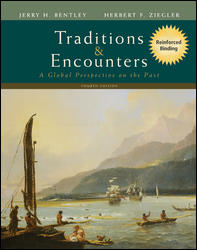Traditions and Encounters, 4th Edition (Bentley)Chapter 2:
EARLY SOCIETIES IN SOUTHWEST ASIA AND THE INDO-EUROPEAN MIGRATIONSOverview
Because of the agricultural transition, societies could sustain larger populations and could become increasingly complex. Thus urban societies emerged in the fourth millennium B.C.E., particularly in the region known as Mesopotamia ("the land between the rivers") along the fertile river valleys of the Tigris and the Euphrates. Some of the world's earliest cities developed and prospered in that region. Mesopotamian prosperity and sophisticated culture attracted many migrants and influenced many neighbors, including the Hebrews, the Phoenicians, and the Indo-Europeans. Some of the characteristics of Mesopotamian societies were
- The establishment of governmental institutions to provide order and stability and to resolve disputes. These institutions evolved into hereditary kingships and, at times, into empires when states sought to expand their dominion to neighboring lands.
- The emergence of social classes as the result of specialization of labor and accumulation of wealth. The agricultural surplus and the accompanying specialization allowed individuals and groups to produce goods of high quality. The desire for these goods, in turn, helped to stimulate trade with other societies, greatly expanding intercultural contact.
- Distinctive cultural traditions that developed including a system of writing that would endure for thousands of years and more elaborate religious institutions than had previously existed.
 | 
















